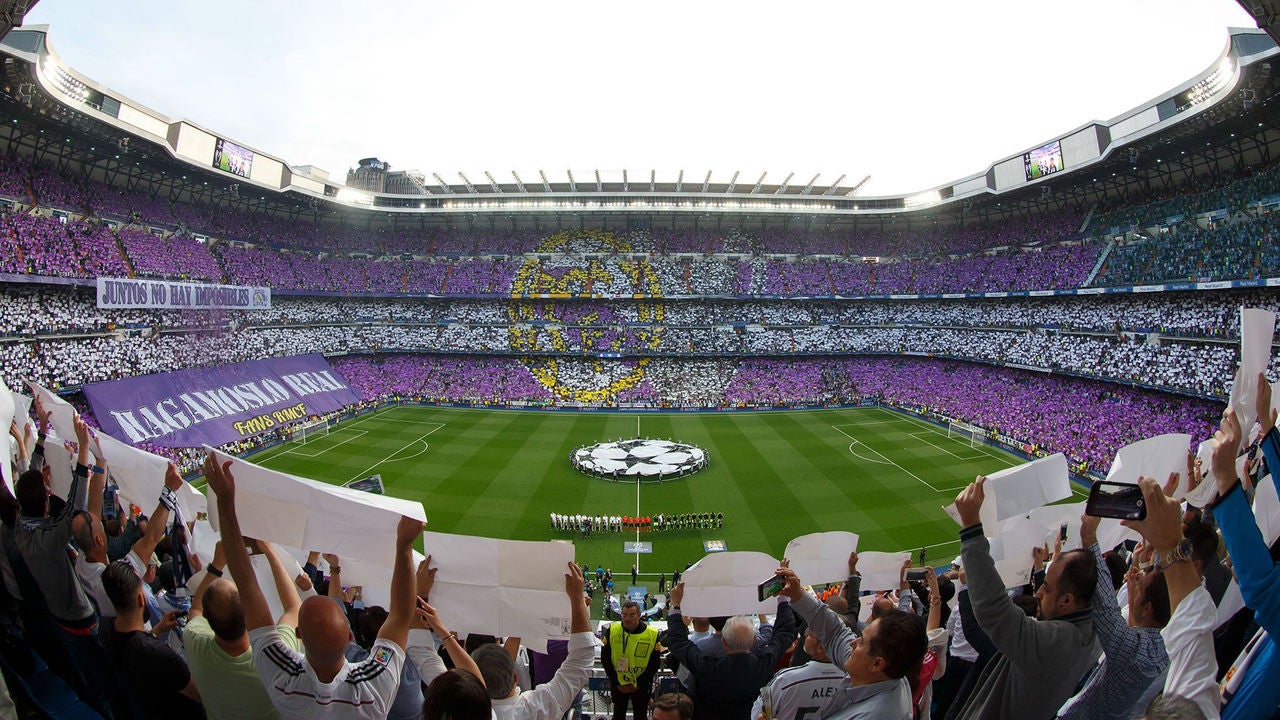Since 1947, this stadium has witnessed the dreams and aspirations of all Real Madrid fans come true.
THE JOURNEY TO BECOMING A SPORTING TEMPLE
In 1943, Santiago Bernabéu was named president of Real Madrid and soon set about launching one of his major projects: the construction of a stadium to meet the demands of an increasingly popular sport and a club that was in continual growth. With the support of club members and fans, who bought season tickets, and with an extraordinarily forward-thinking approach, the club began to build the new Estadio de Chamartín, which opened its doors on 14 December 1947.
Since then, the Santiago Bernabéu has been transformed to become an iconic venue within world sport. In 1952, further development work was undertaken to increase the stadium’s capacity and modernise the arena. In 1955, the club members unanimously voted that the stadium should be named after the president. In 1957, it became the best-lit stadium in the world, whilst in 1965, the club’s offices were moved to the arena.
Our second European Cup crown
In 1957, the stadium played host to the first of the four European Cup finals that the Santiago Bernabéu has witnessed to date. On 30 May, Real Madrid ran out 2-0 winners over Fiorentina, courtesy of goals from Alfredo Di Stéfano and Fransicso Gento, to lift the second continental crown in the club’s history.
Spain’s maiden European Nations’ Cup triumph
On 21 June 1964, our stadium hosted the European Nations’ Cup final, in which Spain overcame the Soviet Union in a 2-1 triumph to claim the country’s first piece of silverware.
Two European Cup finals in 11 years
There was still time for the Santiago Bernabéu to host another major European final before the decade was out. On this occasion, AC Milan and Ajax went head-to-head on 28 May 1969, with the Italians claiming a 4-1 win.
In 1980, the madridista temple hosted another European Cup final. On 28 May, Nottingham Forest secured a 1-0 success over Hamburg.
Venue of 1982 World Cup
Ahead of the 1982 World Cup in Spain and with Luis de Carlos serving as the club’s president, a major redevelopment project was undertaken, with a number of improvements made to the facilities and a large number of seats protected from the elements courtesy of a roof that partially covered three stands. The lighting was once against reinforced and the best video scoreboards of the era were unveiled. During the 1982 World Cup, the Santiago Bernabéu hosted all of the matches in one of the groups and the showpiece, in which Italy saw off Germany in a 3-1 triumph.
The 90s
Under the stewardship of Ramón Mendoza, further redevelopment work was completed that greatly changed the face of the stadium, both internally and externally. Third tiers were added to the stands behind the goals and in the west stands, whilst four towers were erected in each corner to facilitate entry and evacuation and a retractable roof was installed on the east stand.
A new century
Florentino Pérez’s arrival as president in 2000 saw the launch of major plans to develop the Santiago Bernabéu. This phase would result in the modernisation of the facility and the construction of an office building on the façade of calle Padre Damián, whilst the project also revolutionised the concept of stadium use by turning it into an asset for the club on non-matchdays with the new Tour Bernabéu, several restaurants and the greatest sports store in the world.
On 29 September 2002, as a part of the celebrations to mark Real Madrid’s centenary year, our stadium hosted a sporting event that wasn’t related to football. Cycling’s Vuelta de España finished in the stadium with a time trial in which the finishing line was on the Santiago Bernabéu pitch.
Elite Stadium
The investments made on the Santiago Bernabéu since the start of the century reaped their rewards in 2007, when UEFA awarded the stadium Elite Stadium status. This is the highest category conferred by the European organisation and a requirement for the stadium to continue hosting major finals.
2010 Champions League final
Thirty years on from the last time it hosted a final of Europe’s elite club competition, the stadium witnessed the meeting between Inter Milan and Bayern Munich on 22 May 2010, in which the Italians tasted glory courtesy of a 2-0 success.
Historic Copa Libertadores final
Footballing history was rewritten on 9 December 2018, when, for the first time, the Copa Libertadores final was staged outside of the American continent, with the Santiago Bernabéu chosen as the host venue. Following the 2-2 stalemate at La Bombonera, the decider saw River Plate beat Boca Juniors 3-1.
Other major sporting events
Real Madrid have contested two Intercontinental Cup finals and a pair of UEFA Cup finals on the Santiago Bernabéu pitch. The winners of both competitions were decided following two-legged finals. In the Intercontinental Cup we faced Peñarol, in 1960 and 1966, whilst the two victorious UEFA Cup finals were against Videoton (1985) and Köln (1986).
Our stadium has also hosted 36 Spanish Cup finals.
The legacy of Real Madrid, the greatest club of all time, has been forged at the Santiago Bernabéu. On the pitch, the dreams and aspirations of all Real Madrid supporters come true. Over the course of the past decade, we have seen our team lift four European Cups in five years. In 2018, for the first time, a club clinched the European Cups in both football and basketball and the two teams came together to celebrate the feat on the pitch at the madridista temple.

